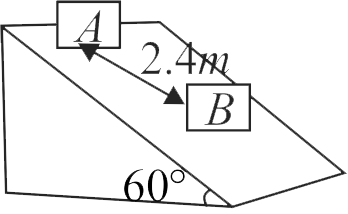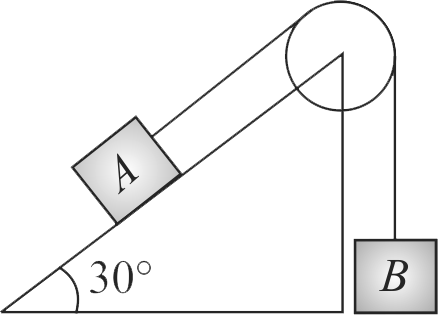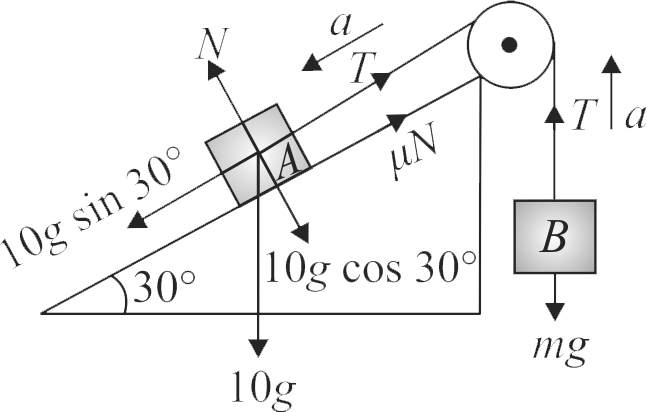363360 A smooth block is released from rest on a \(45^{\circ}\) smooth incline, it sildes a distance \(d\). If it slides same distance on a \(45^{\circ}\) rough incline, the time it takes is ' \(n\) ' times that on identical smooth incline, then the coefficient of friction on rough incline is
363362
Two stationary blocks \(A\) and \(B\) of equal masses are released from an inclined plane of inclination \(60^{\circ}\) at \(t = 0.\) The coefficient of kinetic friction between the block \(A\) and the inclined plane is \(0.4\) while it is \(0.6\) for block \(B\). Initially the block \(A\) is \(2.4\;m\) behind the block \(B\). Both the blocks will come in a line after \(A\) has travelled a distance of how much down the plane.
(Take \(g = 10\;m{\rm{/}}{s^2}\) and \(\sqrt 3 = 1.73\)
363360 A smooth block is released from rest on a \(45^{\circ}\) smooth incline, it sildes a distance \(d\). If it slides same distance on a \(45^{\circ}\) rough incline, the time it takes is ' \(n\) ' times that on identical smooth incline, then the coefficient of friction on rough incline is
363362
Two stationary blocks \(A\) and \(B\) of equal masses are released from an inclined plane of inclination \(60^{\circ}\) at \(t = 0.\) The coefficient of kinetic friction between the block \(A\) and the inclined plane is \(0.4\) while it is \(0.6\) for block \(B\). Initially the block \(A\) is \(2.4\;m\) behind the block \(B\). Both the blocks will come in a line after \(A\) has travelled a distance of how much down the plane.
(Take \(g = 10\;m{\rm{/}}{s^2}\) and \(\sqrt 3 = 1.73\)
363360 A smooth block is released from rest on a \(45^{\circ}\) smooth incline, it sildes a distance \(d\). If it slides same distance on a \(45^{\circ}\) rough incline, the time it takes is ' \(n\) ' times that on identical smooth incline, then the coefficient of friction on rough incline is
363362
Two stationary blocks \(A\) and \(B\) of equal masses are released from an inclined plane of inclination \(60^{\circ}\) at \(t = 0.\) The coefficient of kinetic friction between the block \(A\) and the inclined plane is \(0.4\) while it is \(0.6\) for block \(B\). Initially the block \(A\) is \(2.4\;m\) behind the block \(B\). Both the blocks will come in a line after \(A\) has travelled a distance of how much down the plane.
(Take \(g = 10\;m{\rm{/}}{s^2}\) and \(\sqrt 3 = 1.73\)
363360 A smooth block is released from rest on a \(45^{\circ}\) smooth incline, it sildes a distance \(d\). If it slides same distance on a \(45^{\circ}\) rough incline, the time it takes is ' \(n\) ' times that on identical smooth incline, then the coefficient of friction on rough incline is
363362
Two stationary blocks \(A\) and \(B\) of equal masses are released from an inclined plane of inclination \(60^{\circ}\) at \(t = 0.\) The coefficient of kinetic friction between the block \(A\) and the inclined plane is \(0.4\) while it is \(0.6\) for block \(B\). Initially the block \(A\) is \(2.4\;m\) behind the block \(B\). Both the blocks will come in a line after \(A\) has travelled a distance of how much down the plane.
(Take \(g = 10\;m{\rm{/}}{s^2}\) and \(\sqrt 3 = 1.73\)
363360 A smooth block is released from rest on a \(45^{\circ}\) smooth incline, it sildes a distance \(d\). If it slides same distance on a \(45^{\circ}\) rough incline, the time it takes is ' \(n\) ' times that on identical smooth incline, then the coefficient of friction on rough incline is
363362
Two stationary blocks \(A\) and \(B\) of equal masses are released from an inclined plane of inclination \(60^{\circ}\) at \(t = 0.\) The coefficient of kinetic friction between the block \(A\) and the inclined plane is \(0.4\) while it is \(0.6\) for block \(B\). Initially the block \(A\) is \(2.4\;m\) behind the block \(B\). Both the blocks will come in a line after \(A\) has travelled a distance of how much down the plane.
(Take \(g = 10\;m{\rm{/}}{s^2}\) and \(\sqrt 3 = 1.73\)


